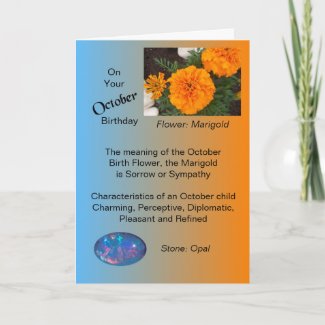Inside text:
Marigold is the flower fairy
for your birthday month.
She brings good wishesfrom your (friends/family/Name)who love(s) you very much.
Cosmos and OpalA fairy picks an Opal that just bloomed on the pink, purple, red and gold Cosmos. A happy illustration for October birthdays!
October Birthday Card - Marigold and Opal
A lovely October birthday card with the flower for October the marigold and the birthstone opal. Also has the meaning of the flower and the characteristics of a October child. Design © www.justbyjulie.com
October's Child
Birthday Marigold
Marigold Flower Symbolism Marigolds are known as the “Herb of the Sun” and are symbolic of passion and creativity. The Welsh believed that if marigolds were not open early in the morning, then a storm was on the way. Marigolds have been used as love charms and incorporated into wedding garlands. Water made from marigolds was thought to induce psychic visions of fairies if rubbed on the eyelids. In some cultures, marigold flowers have been added to pillows to encourage prophetic or psychic dreams. The Marigold and Astrology The marigold is also associated with the lion and the astrological sign Leo. Early Christians named the flower “Mary’s Gold” and offered the blossoms in place of money at the foot of her statues. The Portuguese introduced marigolds into India. Eventually the flower was offered to the Hindu gods Vishnu and Lakshmi. The marigold is also considered to be sacred among the Aztec Indians, who decorate their temples with the flower. The marigold was once thought to protect against the plague and to be effective in stopping gossip. Interestingly, the marigold can symbolize cruelty and jealousy. When used in combination with spells, however, the marigold is an anti-dote for the sharp-tongued and promotes cheery conversations. Marigold Distribution Marigolds can be found in Europe, Africa and the Americas. Marigolds can adapt to a wide range of conditions, but prefer full sun and rich soils. Interesting Facts About Marigolds* The leaves of marigolds have been used to remove warts. Marigolds are also grown and harvested in Mexico to be added to chicken feed. Chickens eating marigold-enriched feed produce eggs with a deep yellow color. The flesh of chickens fed marigolds also take on a rich color to make them more appealing for human consumption The blossoms themselves are quite edible for humans, too, and are often used in egg and cheese dishes. The blossoms also make a yellow dye for fabric. Marigold, also called calendula, is the October birth flower. Sometimes called “summer bride” or “husbandmans dial,” because it’s flower head follows the sun. The Marigold’s flower meaning is “winning grace.” Once considered the most sacred of flowers, in India it was placed around the necks of holy statues. Marigold is found through Europe, the United States, and western Asia. The marigold is an annual flower that blooms well even over a long season. They bloom practically non stop the entire summer and have few problems. Marigolds are good cleansers and can be remedies for the sting of bees. Marigolds are also known as calendula, garden marigold, holligold, goldbloom, golds, ruddes, Mary bud, bull’s eyes, and pot marigold. Courtesy Wikipedia Calendula (pronounced /kəˈlɛndjuːlə/ Ca-lén-du-la), pot marigold, is a genus of about 12-20 species of annual or perennial herbaceous plants in the daisy family Asteraceae, native to the area from Macaronesia east through the Mediterranean region to Iran. Calendula should not be confused with other plants that are also known as marigolds, such as plants of the genus Tagetes, corn marigolds or marsh marigolds. The name Calendula stems from the Latin kalendae, meaning first day of the month, presumably because pot marigolds are in bloom at the start of most months of the year. The common name marigold probably refers to the Virgin Mary, or its old Saxon name ‘ymbglidegold’, which means ‘it turns with the sun’. Marigolds typically bloom quickly (in under two months) in bright yellows, reds, and oranges throughout the summer and well into the fall. Marigolds are considered by many gardening experts as one of the most versatile flowers to grow in a garden, especially since it is easy to grow. Seeds sown in the spring, in most soils, will germinate freely in sunny or half-sunny locations. They do best, however, if planted in sunny locations with rich, well-drained soil. The leaves are spirally arranged, 5-18 cm long, simple, and slightly hairy. The flower heads range from pastel yellow to deep orange, and are 3-7 cm across, with both ray florets and disc florets. They have a spicy aroma and are produced from spring to autumn in temperate climates. It is recommended to deadhead (removal of dying flower heads) the plants regularly to maintain even blossom production. Marigolds are used as food plants by the larvae of some Lepidoptera species including Cabbage Moth, The Gothic, Large Yellow Underwing and Setaceous Hebrew Character. Marigold petals are considered edible. They are often used to add color to salads, and marigold extract is commonly added to chicken feed to produce darker egg yolks. Their aroma, however, is not sweet, and resembles the smell of hops in beer. The oil from its seed contains calendic acid.






